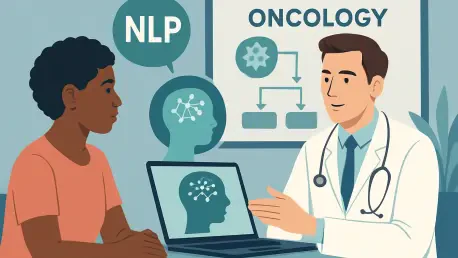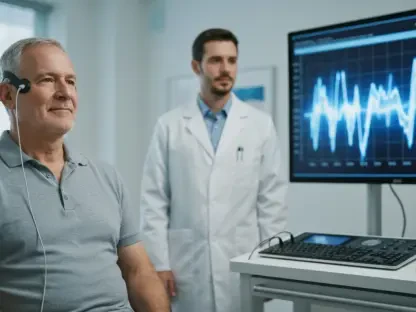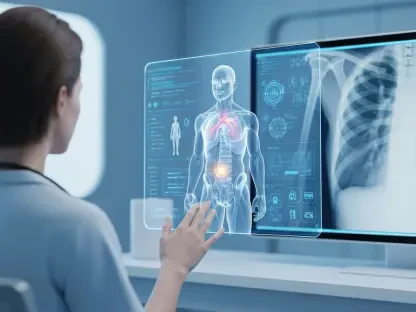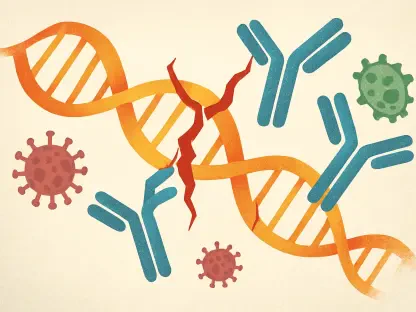Imagine a world where the vast, often chaotic troves of medical records can be instantly decoded to save lives, particularly for cancer patients facing complex diagnoses like brain metastases. In oncology, where every detail in a patient’s history can mean the difference between effective treatment and harmful side effects, the challenge of extracting actionable insights from unstructured clinical notes has long been a barrier. Natural Language Processing (NLP), a powerful subset of artificial intelligence, is stepping in to bridge this gap, transforming raw data into precise, personalized cancer care. This review delves into how NLP is reshaping the landscape of oncology, offering a deep dive into its methodologies, real-world impact, and the hurdles yet to be overcome.
Understanding NLP in the Healthcare Ecosystem
At its core, NLP equips computers with the ability to interpret and analyze human language, a capability that has found profound relevance in healthcare. In an era where electronic health records (EHRs) are brimming with unstructured text—think doctors’ notes, patient histories, and diagnostic reports—NLP serves as a critical tool to extract meaning from this data deluge. Its techniques, such as text mining and semantic analysis, allow systems to identify patterns and insights that would otherwise remain buried under manual review.
The significance of NLP extends beyond mere data processing; it acts as a conduit between raw information and clinical decision-making. In oncology, where precision is paramount, this technology helps distill complex narratives into structured, usable formats. By automating the interpretation of medical language, NLP reduces the burden on healthcare providers while enhancing the speed and accuracy of diagnoses, paving the way for more tailored treatment strategies.
Diving Deep into NLP’s Capabilities in Oncology
Extracting Vital Insights from Clinical Notes
One of the standout functions of NLP in oncology lies in its ability to sift through unstructured clinical documentation to unearth critical diagnostic details. By scanning thousands of notes, NLP algorithms pinpoint key terms and phrases that indicate specific cancer types or subtypes, such as identifying “ductal” as a marker for breast cancer. This process, often achieving accuracy rates above 90%, dramatically cuts down the time clinicians spend on manual record reviews.
Beyond mere identification, the technology streamlines workflows in high-pressure medical environments. Instead of laboriously combing through pages of text, oncologists can rely on NLP to flag relevant information, ensuring no detail is overlooked. This efficiency not only saves time but also minimizes human error, a crucial factor when decisions about radiation doses or therapy types are on the line.
The impact of such data extraction is particularly evident in complex cases where patient histories are dense and multifaceted. NLP’s knack for organizing messy, free-form text into actionable insights allows for quicker, more informed interventions, ultimately improving patient outcomes in settings where every second counts.
Tailoring Cancer Treatments through Classification
Another pivotal application of NLP in oncology is its role in classifying cancer types to personalize treatment plans. For patients with brain metastases, where cancers originate elsewhere in the body and spread to the brain, determining the primary source—be it lung, breast, or kidney—is essential for therapies like stereotactic radiosurgery (SRS). NLP algorithms excel here, often surpassing 90% accuracy in categorization, with near-perfect results for common cancers at 97%.
This classification prowess hinges on sophisticated algorithms that analyze linguistic cues in medical records to deduce cancer origins. Such precision ensures that radiation doses are calibrated correctly, avoiding risks like damage to healthy brain tissue due to overexposure. The ability to differentiate between cancer subtypes further refines treatment, offering a level of customization that traditional coding systems struggle to match.
In practice, this translates to better patient grouping for both clinical care and research purposes. Hospitals leveraging NLP can align treatment protocols with specific cancer characteristics, enhancing outcomes while fostering data-driven studies that push the boundaries of oncology knowledge.
Cutting-Edge Developments in NLP for Cancer Care
The field of NLP is evolving rapidly, with recent innovations making it more accessible and impactful in oncology. Lightweight, scalable models have emerged, requiring minimal computational resources compared to bulkier AI systems. These streamlined tools democratize access, enabling even resource-constrained hospitals to adopt NLP without overhauling their infrastructure.
Integration with EHRs marks another significant stride, embedding NLP directly into existing systems to provide real-time insights. This synergy facilitates a shift toward data-driven healthcare, where decisions are informed by comprehensive, up-to-date patient profiles rather than fragmented snapshots. The trend underscores a broader movement in medicine toward personalization, with NLP at the forefront of this transformation.
Emerging applications also hint at untapped potential, such as combining NLP with other data sources like imaging scans to enhance diagnostic depth. As these advancements unfold, they promise to redefine how oncologists approach everything from initial assessments to long-term treatment planning, cementing NLP’s role as a cornerstone of modern cancer care.
Real-World Impact in Oncology Settings
In practical settings, NLP has already demonstrated transformative value, particularly in managing brain metastases. At leading cancer centers, the technology has been instrumental in identifying primary cancer types from clinical notes, enabling precise calibration of radiation therapies like SRS. This accuracy ensures that patients receive treatments tailored to their specific cancer profiles, minimizing risks and maximizing efficacy.
Beyond diagnostics, NLP enhances interdisciplinary collaboration by standardizing data interpretation across medical teams. Specialists can access consistent, extracted insights, fostering seamless communication that is vital in complex cases. This unified approach not only improves individual patient care but also supports broader research initiatives by creating reliable datasets for analysis.
The outcomes speak volumes—improved patient stratification for clinical trials, faster treatment adjustments, and a reduction in diagnostic guesswork. Such real-world applications highlight NLP’s capacity to turn abstract data into tangible benefits, reinforcing its growing importance in the oncology toolkit.
Navigating Challenges and Limitations
Despite its promise, NLP in oncology faces significant hurdles that temper its adoption. Technical challenges abound, particularly in handling the diverse, often inconsistent formats of clinical data across different healthcare systems. Algorithms must be robust enough to parse varied writing styles and terminologies, a task that remains a work in progress.
Regulatory and ethical concerns also loom large, with data privacy at the forefront. Ensuring that patient information is protected while still enabling effective NLP analysis requires stringent safeguards, a balance that is difficult to strike. Market barriers, such as the cost of implementation and training, further complicate widespread deployment, especially in underfunded medical facilities.
Ongoing efforts to refine models focus on improving adaptability and addressing these ethical dilemmas. Standardization of data formats, coupled with policies to enhance accessibility, could mitigate some barriers, but the path to universal adoption remains fraught with complexity, demanding sustained innovation and collaboration.
Envisioning the Future of NLP in Cancer Care
Looking ahead, the trajectory of NLP in oncology appears poised for groundbreaking expansions. Potential applications include extending its use to a wider array of cancer types beyond brain metastases, harnessing its capabilities to decode patterns in less-studied malignancies. Such broadening could significantly amplify its impact on global cancer care.
Integration with multimodal data, such as combining textual analysis with imaging results, represents another frontier. This holistic approach could offer a more comprehensive view of a patient’s condition, enabling predictions about treatment complications like radiation necrosis. As these integrations mature, they hold the promise of redefining precision medicine on an unprecedented scale.
Long-term, the vision is one of seamless, data-driven oncology ecosystems where NLP not only informs immediate care but also anticipates future challenges. The ongoing refinement of algorithms, paired with strategic partnerships across healthcare and tech sectors, will be key to realizing this transformative potential over the coming years.
Reflecting on NLP’s Journey in Oncology
Looking back, the integration of Natural Language Processing into oncology marked a pivotal shift in how cancer care was approached. Its ability to extract critical insights from unstructured medical data with over 90% accuracy proved to be a game-changer, enabling tailored treatments that enhanced patient outcomes. The scalability of lightweight models further ensured that even smaller institutions could benefit from this technology, broadening its reach across diverse healthcare landscapes.
As the field moved forward, the focus shifted to actionable next steps, such as refining algorithms to handle an even wider spectrum of clinical data variability. Collaborations between technologists and medical professionals became essential to address privacy concerns and standardize implementation protocols. Exploring integrations with emerging diagnostic tools also offered a pathway to deepen NLP’s impact, ensuring that future innovations continued to prioritize precision and accessibility in cancer care.









